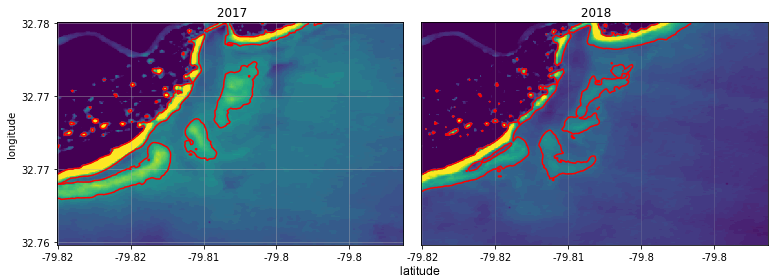F.J.A. Raap1*, R. Gwee2, G.Santinelli2, Etienne Kras 2 , H.E. de Swart1
1 Utrecht University
2 Deltares
*corresponding author:
Abstract
Ebb tidal deltas are subaqueous accumulations of sediment caused by the deceleration of ebbing currents seaward of a tidal inlet. On these deltas, sandy shoals cyclically form and migrate towards the coast, thereby transporting large volumes of sand to the adjacent beaches. A detailed understanding and subsequent monitoring of these environments have important implications for coastal management. Automated monitoring methods for quantifying morphological patterns can help to speed up and standardise the analysis, contributing to timely updates on the state of the coasts and important trends. Previous studies, such as Gaudianao & Kana (2001) and Ridderinkhof et al. (2017), have manually quantified the characteristics of the shoals based on aerial photographs and satellite images. Owing to low temporal resolution, the results still contain large uncertainties. Furthermore, the manual nature of the analysis renders the results subjective and is time-consuming. Within the last several years, an automated methodology was developed at Deltares to derive subtidal and intertidal bathymetry based on satellite images. The satellite-derived bathymetry (SDB) product provides large spatial coverage, enabling morphological analyses in areas with little or no in-situ bathymetric data. In this project, the satellite-derived bathymetry is used to quantify lifetimes, periods and migration speeds of sandy shoals on ebb-tidal deltas of different systems. Results that will be presented include 1. supplementation and enhancement of greatly researched systems such as the Vlie inlet (Waddenzee, the Netherlands) and Breach inlet (east US coast) 2. analysis of a system where little is known about its dynamics (Eierlandsegat, the Netherlands). Phenomena of interest, such as bypassing events, can be captured within SDB due to its sufficiently high temporal resolution (see Fig. 1). Through computer vision methods, shoals can be isolated, allowing for their behaviour to be quantified through time and space. Finally, the reliability of the method is assessed by comparing the results with in-situ bathymetry and earlier research.

Figure 1: SDB images of bypassing event of shoals near Breach Inlet (east US coast) in 2017 and 2018. Morphodynamic features are isolated and contoured in red. The shoals are formed at the mouth of the inlet in the north and migrate towards the south where they in the end attach to the beach.
References
Gaudiano, D. J., & Kana, T. W. (2001). Shoal bypassing in mixed energy inlets: Geomorphic variables and empirical predictions for nine South Carolina inlets. Journal of Coastal Research, 280-291.
Ridderinkhof, W., Hoekstra, P., Van der Vegt, M., & De Swart, H. E. (2016). Cyclic behavior of sandy shoals on the ebb-tidal deltas of the Wadden Sea. Continental Shelf Research, 115, 14-26.
I. Surname1*, F.N. Another-Surname2 , Y. Next-Surname2
1 University Name, Country; 2 Organization Name, Country
* Corresponding author: mail.name@organization.org


